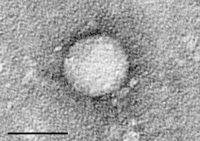
Photo from wikipedia
Simple Summary Tyrosine kinase inhibitors (TKI) can be safely discontinued in chronic myeloid leukemia patients. Achieving a sustained deep molecular response (DMR) before stop is recommended. Currently, the proportion of… Click to show full abstract
Simple Summary Tyrosine kinase inhibitors (TKI) can be safely discontinued in chronic myeloid leukemia patients. Achieving a sustained deep molecular response (DMR) before stop is recommended. Currently, the proportion of patients who achieve a sustained DMR remains to be determined. Based on the follow-up of 398 patients over a ten-years period, we evaluate that 46% of them have achieved a sustained DMR. Gender, BCR-ABL1 transcript type, and disease risk scores were significantly associated with the probability of achieving a DMR. 95/398 (24%) patients stopped TKI with a probability of maintaining molecular reponse without TKI resumption of 47% at 48 months after stop. In this study, TKI duration before stop and second (nilotinib, dasatinib, bosutinib) generation frontline TKI compared to imatinib were significantly associated with a lower risk of molecular relapse after stop in patients who have achieved a sustained DMR. Abstract Background: Tyrosine Kinase Inhibitors (TKIs) discontinuation in patients who had achieved a deep molecular response (DMR) offer now the opportunity of prolonged treatment-free remission (TFR). Patients and Methods: Aims of this study were to evaluate the proportion of de novo chronic-phase chronic myeloid leukemia (CP-CML) patients who achieved a sustained DMR and to identify predictive factors of DMR and molecular recurrence-free survival (MRFS) after TKI discontinuation. Results: Over a period of 10 years, 398 CP-CML patients treated with first-line TKIs were included. Median age at diagnosis was 61 years, 291 (73%) and 107 (27%) patients were treated with frontline imatinib (IMA) or second- or third-generation TKIs (2–3G TKI), respectively. With a median follow-up of seven years (range, 0.6 to 13.8 years), 182 (46%) patients achieved a sustained DMR at least 24 months. Gender, BCR-ABL1 transcript type, and Sokal and ELTS risk scores were significantly associated with a higher probability of sustained DMR while TKI first-line (IMA vs. 2–3G TKI) was not. We estimate that 28% of CML-CP would have been an optimal candidate for TKI discontinuation according to recent recommendations. Finally, 95 (24%) patients have entered in a TFR program. MRFS rates at 12 and 48 months were 55.1% (95% CI, 44.3% to 65.9%) and 46.9% (95% CI, 34.9% to 58.9%), respectively. In multivariate analyses, first-line 2–3G TKIs compared to IMA and TKI duration were the most significant factors of MRFS. Conclusions: Our results suggest that frontline TKIs have a significant impact on TFR in patients who fulfill the selection criteria for TKI discontinuation.
Journal Title: Cancers
Year Published: 2020
Link to full text (if available)
Share on Social Media: Sign Up to like & get
recommendations!